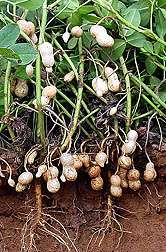New Farming Wrinkle May Help Peanut Growers

(PhysOrg.com) -- Using a combination of conservation tillage and deficit irrigation management in peanut production can promote conservation of water during the early growing season without hurting yields, an Agricultural Research Service (ARS) scientist reports.
That's good news for peanut farmers in the Southern High Plains, where water is often in short supply, particularly in areas where residential development has increased demands for water. Irrigation also adds to the cost of production for growers.
Deficit irrigation, or forced drought, early in the growing season appears to result in quicker maturation while maintaining yields, according to ARS agronomist Wilson Faircloth at the National Peanut Research Laboratory (NPRL) in Dawson, Ga., and plant physiologist Diane Rowland, formerly with NPRL and now with Texas A&M University. They conducted a five-year field trial in West Texas to determine the effects of deficit irrigation. More recently, they've also studied how conservation tillage can help boost peanut production.
Results indicate that induced early-season drought may serve to acclimate the crop to drought stress that commonly occurs during late-season growth, according to Faircloth. It is also during this latter part of the growing season that growers typically experience water deficits due to reduced pumping capacity, thus increasing the risk of yield reductions.
Faircloth and Rowland also investigated the use of conservation tillage with a cover crop to mitigate drought. They applied varying amounts of water to peanut and cotton planted in either conservation or conventional tillage. They found that, under drought conditions, conservation tillage increased peanut yields when compared to conventional tillage. The yield increase was attributed to increased water-holding capacity of the soil under conservation tillage, and changes in peanut rooting patterns.
Additionally, the combination of conservation tillage and deficit irrigation could greatly reduce water requirements for peanut and cotton.
Read more about this and related research to improve peanut production in the January 2010 issue of Agricultural Research magazine.
Provided by USDA Agricultural Research Service















